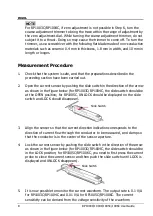
RIGOL
RP1003C/1004C/1005C/1006C User Guide
11
input under standard conditions. Self-heating may increase if the ambient
temperature increases or the measurement current waveform contains other
frequency components. Refer to
Appendix 2 Relation between Max Input
Current and Frequency
.
3.
If excess current is input, generated heat activates a built-in safety function that
blocks normal output. If this happens, remove the input immediately (remove
the sensor from the conductor being measured, or reduce the input current to
zero). Wait until the sensor has had sufficient time to cool before resuming
operation.
4.
Heating generated during measurement of the current with a frequency of 1
kHz or higher is mainly attributed to the self-heating of the sensor head. In this
case, the built-in safety function will not be activated. Be careful to avoid
accidents, such as a burn by heat, short-circuit, and damage to the sensor.
5.
Even if the input current does not exceed the rated continuous input range,
continuous input for an extended period of time may result in activation of the
safety circuit to prevent damage resulting from heating of the sensor.
6.
At high ambient temperature, the built-in safety circuit may activate at current
input levels below the rated continuous input range.
7.
Continuous input of current exceeding the continuous input range or repeated
activation of the safety function may result in damage to the device.
8.
The maximum input range is indicated by the
Maximum Continuous Input
Range
. It is also indicated by another product specification
Maximum Peak
Current Value
. Make sure that the input does not exceed the continuous
maximum input range in rms.
9.
Do not place any unclamped conductor with an electric current of a frequency of
10 kHz or higher near the sensor head. Current flowing in the conductor nearby
may heat up the sensor head and cause its temperature to rise, leading to
damage to the sensor.
RP1003C/RP1004C
RP1005C/RP1006C
10.
When opening the sensor head of the probe, be sure to operate with the
Upper Core
Summary of Contents for RP1003C
Page 1: ...User Guide RP1003C 1004C 1005C 1006C Current Probe Sept 2020 RIGOL TECHNOLOGIES CO LTD ...
Page 2: ......
Page 10: ......
Page 29: ...RIGOL RP1003C 1004C 1005C 1006C User Guide 19 RP1005C RP1006C ...
Page 31: ...RIGOL RP1003C 1004C 1005C 1006C User Guide 21 RP1005C RP1006C ...
Page 33: ...RIGOL RP1003C 1004C 1005C 1006C User Guide 23 RP1005C RP1006C ...



























